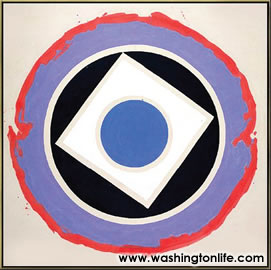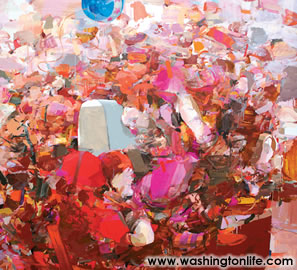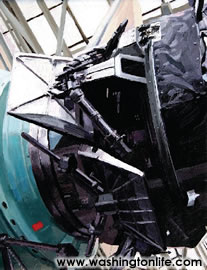From Pop to SurrealismTHE D.C. ARTS SCENE: Past, Present and Future BY CHRISTINA WILKIE
Washington art lover Christina Wilkie explores the rewards and potential pitfalls of buying art in the nation's capital. During the 1960's and early 1970's, Washington was the center of a dynamic movement in contemporary art, identified as the Washington Color School. Consisting of an original group of six artists and their successors, the Color School movement challenged prevailing notions of abstraction by employing primary colors on canvases with a bold new simplicity. Artists affiliated with the School earned international acclaim for their innovative work, and residents responded by buying up the works of Morris Louis, Gene Davis and Ken Noland on pure speculation. These were certainly heady times, but in the three decades since the heyday of the Color School the visual arts in Washington have suffered from a form of "brain-drain," most visible in the veritable laundry list of "hot" young artists who have migrated from Washington to New York and California in hopes of gaining national attention. One of the many side effects of this long-term shift away from the visual arts in Washington was the reinforcement of a notion that the nation's capital wasn't home to a dynamic art market. Certainly, Washington doesn't yet inspire collectors to descend upon it for one fabulous week each year (like Basel), nor is it known as a particularly friendly city for starving geniuses (like San Francisco). However, in the past ten years the city has changed dramatically, evolving from what one gallery owner called, "a bedroom community that would roll over every four years," into a booming capital with an ever expanding perimeter. This new, widening Washington metro area owes much of its growth to innovative companies that employ a highly educated workforce, resulting in the nearly decade-long boom in the local housing, education and retail markets.
Interestingly enough, urban markets for visual arts seem to work on a delayed timer with respect to an area's economic development, with markets often surging five to ten years into a period of sustained economic growth. Boston and Atlanta are prime examples of this phenomenon; Atlanta's arts market is still enjoying the fruits of the mid 1990's economic surge there. By this logic, Washington is poised for a large-scale renewal of its once thriving visual arts market, and a chance to challenge the old stereotypes and get new collectors into the market. THE WASHINGTON ARTS SCENE EXPERIENCED BY AN AMATEUR
My next stop was the hip neighborhood that has grown up over the last five years at the intersection of 14th and P Streets, just below Dupont Circle. I visited two small galleries known for showing quality cutting-edge art: Fusebox Gallery on 14th Street (which proving the precarious nature of art gallery survival, just closed down), and the Transformer Gallery around the corner on P Street. At Fusebox Gallery I came upon the work of Ian Whitmore, a 26-year-old painter educated at American University, who exemplifies the potential of the local art scene. Whitmore's major pieces usually begin with a classical representation, over which he imposes chaotic abstractions that effectively dissolve the original image without ever fully abandoning it. The chaos in his scenes evokes a simultaneous feeling of mayhem and rapture, and the oil canvases glow with the energy of his brushstrokes and colors. Whitmore is a great example of the type of artist that amateur collectors would do well to acquire. He is young, brilliant and still widely unknown on a national level, but his work shows both outstanding quality and the steady development of a signature style. These two factors are particularly important to anyone who's thinking of buying the work of an emerging artist. No surprise, then that he has sold out all of his shows with his second famously selling out before it even opened. Yet, his work is still reasonably priced (around $10,000 for a fivefoot by five-foot work), making it even more accessible to the amateur collector. SAVE THE DATE UPCOMING SHOWS AT DC INDEPENDENT GALLERIES March 3 March 4 March 4 March 18
|
||||||||||||||



